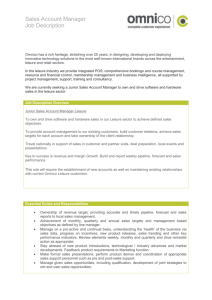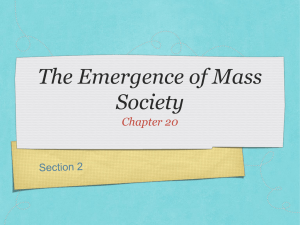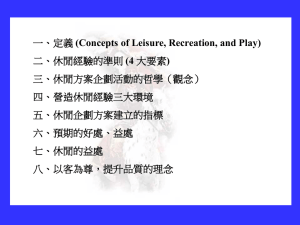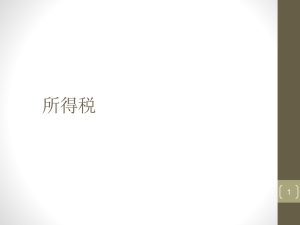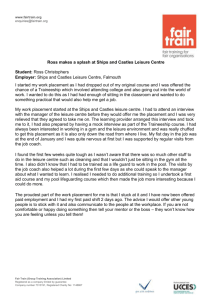Unit 3 – Getting it right in the Leisure Industry – Case Study
advertisement
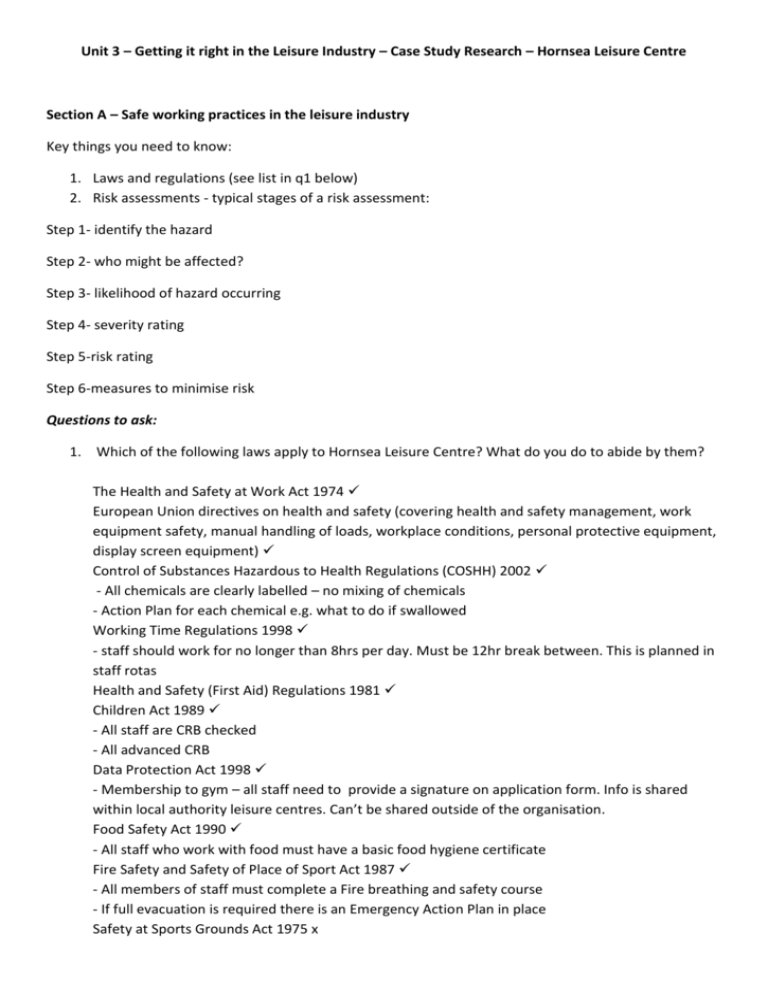
Unit 3 – Getting it right in the Leisure Industry – Case Study Research – Hornsea Leisure Centre Section A – Safe working practices in the leisure industry Key things you need to know: 1. Laws and regulations (see list in q1 below) 2. Risk assessments - typical stages of a risk assessment: Step 1- identify the hazard Step 2- who might be affected? Step 3- likelihood of hazard occurring Step 4- severity rating Step 5-risk rating Step 6-measures to minimise risk Questions to ask: 1. Which of the following laws apply to Hornsea Leisure Centre? What do you do to abide by them? The Health and Safety at Work Act 1974 European Union directives on health and safety (covering health and safety management, work equipment safety, manual handling of loads, workplace conditions, personal protective equipment, display screen equipment) Control of Substances Hazardous to Health Regulations (COSHH) 2002 - All chemicals are clearly labelled – no mixing of chemicals - Action Plan for each chemical e.g. what to do if swallowed Working Time Regulations 1998 - staff should work for no longer than 8hrs per day. Must be 12hr break between. This is planned in staff rotas Health and Safety (First Aid) Regulations 1981 Children Act 1989 - All staff are CRB checked - All advanced CRB Data Protection Act 1998 - Membership to gym – all staff need to provide a signature on application form. Info is shared within local authority leisure centres. Can’t be shared outside of the organisation. Food Safety Act 1990 - All staff who work with food must have a basic food hygiene certificate Fire Safety and Safety of Place of Sport Act 1987 - All members of staff must complete a Fire breathing and safety course - If full evacuation is required there is an Emergency Action Plan in place Safety at Sports Grounds Act 1975 x Licensing Laws x Reporting of Injuries, Diseases and Dangerous Occurrence 1995 (RIDDOR) - All accidents should be reported. (what? Treatment? What was said? Date? Time? Where? - Can’t deal with past injuries – advise about going to GP - Complete online form and send to coastal area H&S officer or complete paper form and post to appropriate person. All staff are suitably qualified (see http://asleisure.wikispaces.com/unit2_hornsea_leisure_centre ) 2. What risk assessments have you completed for Hornsea Leisure Centre? Wide range of Risk assessments completed. Range from reception, gym, pool and sports hall. Staff cannot produce a risk assessment until they have completed a 5 day IOS course. 3. How often do you complete risk assessments? Why? Unwritten – 3 times per day Written – reviewed 4 times per year. 4. What is your procedure for completing risk assessments at Hornsea Leisure Centre 5. What advice do you give to new staff with regards completing risk assessments? New staff cannot complete risk assessments unless they have completed the 5 day course. When training to be a life guide trained to be able to complete a RA (though this is not enough to complete leisure centre RA) 6. How often do you carry out a risk assessment of Hornsea leisure centre? 7. What are the most common risks in the leisure centre? - water - electrical - trips - falls Lk for: Examples of risk assessments – ask them for copies!!!! Examples of potential risks Resources available to help reduce risks Section B - Quality control and management systems used in the leisure industry Key things you need to know: Key elements of IIP: Commitment: invest in people to achieve business goals, i.e give them more training Planning- show how the training will be done Action- show how any action will be move the organisation to its goals Evaluation- checking that what was planned has been achieved. Questions to ask: 1. Why is it important to have quality control systems in place for leisure organisations? • • • • • • • monitoring the feedback made by customers suggestion boxes surveys (of customers, staff, management, non-users) focus groups (monthly group meeting) (customer forum – meet every 3 months – dicsuss problems / recommendations / improving centre facilities – free lunch provided (see minutes from last meeting) mystery callers observation other – online form How effective are these techniques? Focus group – very effective – see minutes of meetings Suggestion boxes – limited effectiveness – few people use the facility Mystery callers – very effective – instant feedback and people are not prepared for them therefore it is an accurate measure of the quality of service offered on the phone. How do you define the quality of your customer service (e.g. minimum number of rings for telephone calls / customers should not wait more than 2 minutes at the reception desk etc.) Telephone call: rings – 8 maxGood morning > give name > ask how can help Pass on to duty manager if cannot help 2. 3. 4. 5. 6. Have you achieved the Investors in people award? - Yes How did you achieve this? – develop portfolio of evidence > IIP reviewed evidence and interviewed staff. What does this mean to the organisation? Commitment, Planning, Action and Evaluation are the key principles towards achieving the IIP standards which is your strongest area and why is this? Have you achieved any of the following industry recognised awards: QUEST award - Yes FIA (Fitness Industry Association - FLAME AWARD REPS – All staff have reps qual l2>l4 Walk to Health Award – yes Heart Link Award - yes Has your organisation benefited from these awards? 8. Have there been any problems with the award such as costs too much and some staff have not adapted to the system very well? No – the have helped set the standard > evidence that staff can meet standards 9. Why is it important for Hornsea Leisure Centre to develop systems and technology to ensure that records are accurate. Refer to your organisation in terms of: • customer records – BEARS computer database > book online or through reception • booking/reservation systems – BEARS computer database • membership schemes – Instant loyalty System (data base) • ticketing systems (p112-113) > online and in leisure centre • customer complaints 7. Lk for: Evidence of achieving awards. Section C - Business Systems Key things you need to know: You need to understand why it is important that the systems used by organisations are ‘customer friendly’ and easy for the staff to use. You need to research the impact that advances in technology have had on the business systems used in the leisure industry. You need to analyse how technology impacts on the efficiency of your chosen leisure organisation. Questions to ask: 1. What business systems do you have in place for sales? 2. What business systems do you have for payroll? 3. 4. 5. 6. 7. 8. How you pay your staff? (Cash / into bank accounts) - Monthly > paid using BACS > last working day of the month Do you use BACS? (Bankers Automated Clearance Services BACS – scheme for electronic processing of financial transactions) Yes At what times do you pay your staff? (Weekly / monthly) > Monthly What business systems do you have in place for booking systems? What business systems do you have in place for loyalty cards? What business systems do you have in place for customer database? Why are the business systems important too your organisation? How does your organisation use ICT facilities to help run the organisation? What do you think the importance of ICT in supporting these business systems? Financial records: What are your sources of finance? How do you go about budgeting Do you create break-even forecasts How do you complete cash-flow forecasts - Monthly sales meeting for head of each leisure centre. Shared offers across the authority e.g. March Madness (15 months for 12) Personnel Records: How do you record: • recruitment and selection • personnel • disciplinary and grievance procedures • appraisal and training • consultation and communication. What systems and technology do you have in place for: • sales records • stock control and purchasing • staff payroll systems • customer accounts, billing systems and receipts • customer payment. How are systems are used to plan, monitor, control and review the finances of Hornsea Leisure Centre? Section D – Key Aspects of Marketing Used in the Leisure Industry Key things you need to know: Key aspects of marketing used in the leisure industry. to understand how and why organisations set marketing objectives, use analyses of internal and external influences using SWOT and PEST, Develop a marketing mix that is appropriate to the organisation. The 4 P’s They try to offer the right product to us at the right price, selling it at the right place through effective promotion. Questions to ask: PRODUCT What products do you offer at your leisure centre? How do you know if your products are at a good standard? PRICE Do you price your products at what they are worth or do you make a profit from them? PLACE Do your customers know what products are available here? How do you attract customers from other areas? PROMOTION Does your staff have a detailed knowledge of the products on offer? How do you promote your products? ADVERTISING How do you advertise the use of your leisure centre? Newspapers Magazines Radio Television Internet Posters Other DIRECT MARKETING Directs the promotion to a specific customer and enables organisations to target market segments. Do you use any forms of direct marketing? Direct mail? Telemarketing? Door-to-door distribution? PUBLIC RELATIONS MEDIA INCLUSION? Has the leisure centre ever been filmed as part of a programme or documentary in the hope to attract customers? COMMUNITY RELATIONS? Do you have a good relationship with the local community? How do you maintain a good relationship with the community? CORPORATE COMUNICATIONS? Do you have a corporate image that is recognised? What made you decide on the colours, logos and fonts of the image? SALES PROMOTION Do you have any sales promotions? Do you have any sponsorships? TECHNOLOGY Does technology allow for products and services to be made more cheaply and to a better standard of quality? Lk for: Examples of promotional materials (and take copies) Examples of wall displays / posters etc.

